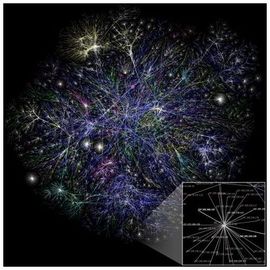|
|
SWARM-REDISTRIBUTION
Decentralised, Distributed, P2P-Dividend Pathways Author: @bipedaljoe Introduction The Resilience Network, a state 2.0, uses transaction data to compute self-organizing clusters in a global financial network. It leverages p2p-algorithms to create a self-organizing, decentralised welfare system, that covers the basic needs each user has to meet in order to avoid amygdala-excitation and ego-collapse. The Resilience Network has been designed to provide a feeling of abundance, of security, and to obsolete the tension that has influenced our species narrative. Like I have written, a basic income ecology is privy to a radically different idea-space then the idea-space of a capitalist ecology. The world is infinitely vast, and infinitely open. This is a technology that allows its users to make artificial scarcity a thing of the past. The basic income revolution through p2p-technology, deployed at a planetary scale. 
Peer-to-Peer Technologies The concept of swarm-redistribution, as I call it right now, is to provide basic social resilience through a peer-to-peer mechanism. The idea is that the patterns of altruistic reciprocity and mutual interdependence that a swarm exhibits should be the patterns we go by. P2P-dividends render a welfare system at the level of self-organizing p2p-clusters. Peer-To-Peer Dividends The Resilience Network collects tax from the people who connect to it, and redistributes it in the form of p2p-dividends. The service is agnostic towards who and whom connects to it. It collects tax based on their transactions, and then shares that tax with what it computes as a swarm. Trophic chain The creative output of any given person is an asset. Like photosynthesis. Each person is like a plant producing glucose. The plant fuels the rest of the biosphere, and the person fuels the state, or swarm. The narratives that we have been privy to have talked about states as static entities, but they´re more like swarms. Like swarms of bees, or schools of fish. How to Create a welfare system based on peer-to-peer principles The solutions is to go by trophic chains in creative output. Each level of the trophic chain provides for the swarm who consumes from it. There´s a recursive, fractal pattern to it. Each node is the center of it´s own universe, and each node´s creative output supports it´s own unique swarm. Swarm-Redistribution Algorithm Each node sends p2p-dividends to everyone who has sent a payment to that node. And to every who has sent a payment to that node. And to everyone who has sent a payment to that node. I have an examples script, http://www.resilience.me/swarm_redistributionjs.html But how do you implement it, realistically ? It´s obvious that it would require a super-computer per transaction. I´ve designed solutions to it, and they work. The system wants to collect tax, and it wants the accounts themselves to pay out that tax. The system acts as a middle-hand who generates a list of who should get the payments. That´s basically all it does. A list, based on the three laws, and the swarm-redistribution algorithm. The system wants to redistribute taxed money based on the principles I´ve written about on the THEORY page. The system is happy as long as the resources are redistributed, but it could take shortcuts to get there. Somewhat like how Ripple does rippling. The system solves this by 'rippling' the flow of tax. If multiple accounts send tax to the same account, then those payments will be issued by just one of the accounts, and the other accounts will issue that accounts left-out payments. Everyone gets what has been redistributed to them, but the pathways are malleable. This also decreases the load on the financial network-side. Each account might issue just a couple of payments, instead of thousands, or infinitely many. The $4 that you might tax when you buy something in the $100-$1000 won´t be payed out to an infinitely large 'swarm', but to just a few accounts. The rest of your swarm will receive from accounts that have aggregated their dividend. The resilience network (or I´ll use resilience.me to avoid ambiguity), resilience.me, receives raw and complete data-input from its users, calculates the most efficient way to redistribute the payments, and returns unsigned payments to the users. The pulses of swarm-redistribution could also be limited in how far they can propagate. The electric resistance (R) of the conductive pathways could be designed to make it flow like you want it to flow. the limit could be quantitative in $, or in ratio/quota pulses could also aggregate to form larger pulses, payments could be collected, like water in a drainage-pipe-sewer system. or deoxygenetaed blood heading towards vena cava. That answers the only complications I see with the concept. I´ll improve this whitepaper as soon as I have a working prototype of swarm-redistribution. For now, look at http://www.resilience.me/swarm_redistributionjs.html, and fork my work, and stay awesome :) Swarm-Redistribution API Swarm-redistribution is a generic function, a general purpose algorithm. As I´ve written here, http://www.resilience.me/letter-how-to-create-resilience.html, the substrates are of lesser importance. The function per se is generic. The next step is to create a generic API, https://twitter.com/resilience_me/status/535919488706023424, that receives input from any currency / coin / financial platform, runs the swarm-redistribution algorithm, and returns a list of outgoing payments. look towards http://basicincome.co |
|
